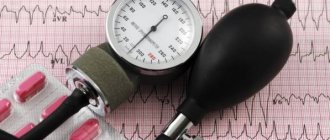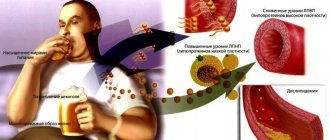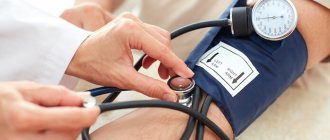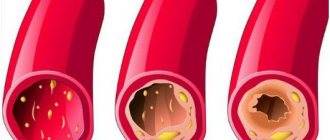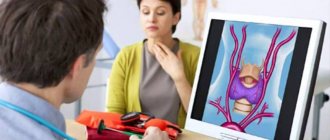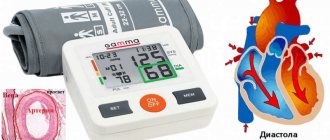Is there any danger
High blood pressure of 160 over 100 is dangerous because, if left untreated, it can cause a number of adverse consequences that pose a threat to the health and life of the patient. Possible complications include:
- Brain stroke.
- Cardiac muscle infarction.
- Aortic aneurysm.
- Kidney dysfunction.
- Visual impairment.
- Heart failure.
High blood pressure of 160/100 does not normalize on its own, so you need to urgently consult a doctor and get treatment. If you do not take any measures, dangerous consequences will not keep you waiting.
A blood pressure of 160 over 100 can cause blurred vision.
Reasons for the increase in indicators in women
In women, pressure 160 over 100 often occurs due to hormonal changes. Women often experience hormonal changes. The level of hormones during menstruation changes monthly; hormonal levels are affected by pregnancy, the postpartum period, and menopause. Pressure surges can be constant or periodic; the need for treatment depends on the degree of increase and frequency.
Menstrual cycle
Every month, a woman’s body undergoes hormonal changes. Hormone surges are triggered by an excess of estrogen, which causes blood vessels to narrow and blood levels to increase.
Due to vasoconstriction and pressure surges, a woman’s well-being during menstruation worsens. Severe malaise occurs on the first and second days of the cycle, then estrogen levels drop, and health improves.
Blood pressure during menstruation does not increase in all women and is not a pathology.
Pregnancy
During the period of bearing a child, a woman’s body undergoes serious changes. Organs and tissues work in an intensive mode, the circulatory system has to pump blood to supply the organs of the woman and the fetus. All processes in the body are rebuilt. Blood pressure is constantly changing, regular pressure surges are acceptable, but the degree of increase must be controlled.
The difference between the upper and lower indicators during the period of bearing a child should not exceed 50 points. If the pressure changes several times a day, you should monitor your general condition.
Constant surges in pressure can trigger the development of eclampsia. This is a dangerous pathology that can lead to sudden death of the mother or death of the fetus.
During pregnancy, blood pressure may increase, so its levels need to be monitored
Postpartum period
After childbirth, a woman’s body begins to rebuild in the reverse order. Hypertension can periodically increase due to unstable blood flow, as the vessels become accustomed to pumping more blood.
After delivery, the pressure should stabilize. If this does not happen, you need to contact a cardiologist, who will look for the cause of a persistent increase in blood counts to 160 to 100 points.
Menopause and menopause
Female menopause cannot be corrected. During menopause, a woman needs to visit a doctor who will prescribe medications to stabilize the condition.
High blood pressure of 160 over 100 in women is most often caused by disturbances in the functioning of the endocrine system. These are natural processes occurring in the body, caused by hormonal changes. Therapy in these cases is not required.
Features of isolated hypertension
In most cases, pressure increases in both indicators at once. Therefore, at a time when there is a systolic pressure of 160, and the diastolic pressure is within the normal range, patients are lost in the issue of first aid. Conventional antihypertensive drugs can lower both levels, which has its own risks.
In the elderly, a condition such as isolated hypertension is often observed, when only the upper pressure increases
If only the upper indicator increases, we are talking about isolated hypertension. This deviation is especially common in older people. The reason in this case is a decrease in the elasticity of blood vessels. Subsequently, this can lead to pathologies of the kidneys and heart.
The condition is no less dangerous for young people. If abnormalities are detected early, there is a possibility of rapid progression of the pathology to the final stage. This can lead to frequent complications and even death.
Reasons for rejection
The following reasons can provoke deviations in the upper indicators:
- malnutrition - excess salt provokes fluid accumulation, which causes an increase in blood pressure;
People who are overweight are more likely to develop hypertension
- increase in body weight - due to increased load, the vessels simply cannot cope with the volume of blood;
- lack of potassium – if the balance of microelements is disturbed, a change in water-salt metabolism is noted;
- lack of movement - negatively affects vascular tone;
- bad habits – increase the risk of blood clots.
Isolated hypertension can be observed against the background of serious renal dysfunction, diabetes mellitus and liver failure.
Diabetes can also lead to the development of isolated hypertension
Signs of pressure 160/90
It is characteristic that with such tonometer readings, the disease may not manifest itself in any way. The first sign, and sometimes the only one, is sleep disturbances. This alone should alert the patient and cause him to see a doctor. Light sleep may also indicate isolated hypertension.
Further, as the pathology progresses, the following signs appear:
- noise in the head;
- skin hyperemia;
- irritability;
- dizziness;
- sweating;
- pronounced palpitations;
As hypertension progresses, numbness in the fingers may occur.
- numbness of fingers;
- swelling (mainly in the facial area);
- increased fatigue.
The listed symptoms require a thorough examination of the patient and determination of the cause of the deviations. Only after this can treatment be prescribed.
How to lower systolic blood pressure
If, as a result of the change, it turns out that blood pressure levels are maintained at 160/100 (90) mm Hg. Art., first aid should be started immediately. Captopril or Nifedipine will help relieve the attack. A tablet is enough, but it needs to be dissolved, not swallowed. After this, the pressure should begin to decrease. After 30-40 minutes you need to take repeated measurements. If the condition does not improve, you should call a doctor.
It is very important to consult a doctor so that he can prescribe comprehensive treatment
After the attack of hypertension is relieved, you should see a doctor as soon as possible. He will prescribe a long course of medications to help return the blood vessels to normal. In addition, medications should be used, the choice of which is based on the cause of the deviation.
In parallel, the following recommendations must be observed:
- reduce salt intake;
- eat more fruits and vegetables, but you need to give up fat;
- provide the body with moderate exercise;
- get rid of bad habits.
It is very useful for hypertensive patients to eat more fruits and vegetables
Even after the pressure has been stabilized, you cannot return to your previous lifestyle. Hypertension is a chronic pathology, and it must be treated constantly, avoiding progression and crises. This can only be achieved by regularly taking medications and following the above recommendations.
From this video you will learn about high blood pressure:
If the pressure is 160 over 100, what should you do?
And now - to the specifics. The ideal pressure markers, as everyone probably knows, are considered to be 120/80 mmHg. Art. But medicine does not deny that not the most significant, but still discrepancies with this value, can be considered the norm. And here a dangerous “fork” of reasoning arises: everyone has their own blood pressure norm - this is one thesis, and 129/85 will also be the norm - another thesis.
It would be useful for every hypertensive patient to know:
- There is no such thing in medicine as “everyone has their own norm.” A blood pressure of 160/100 cannot be normal, just as 80/60 cannot be normal.
- Modern cardiologists have also abandoned the concept of “working pressure”. Instead, the more correct and accurate “target pressure” is used, i.e. those individual indicators that fall within the normal limits to which you need to strive.
- The pressure does not decrease one-time. By taking the pill, you will ensure the effect of normalizing blood pressure, which lasts for several hours (maximum a day or two). But then the pathology that underlies hypertension will be active again. And, therefore, the pressure will increase again. Therefore, the treatment is prolonged, regimented, precise.
If the pressure is 160 over 100, what does this mean? This absolutely means that it is increased. This is not an individual norm. The question is, how long do you have this blood pressure? If it’s a one-time thing, if it’s due to stress, illness, acclimatization, perhaps everything can be explained by physiological changes. But then the pressure normalizes on its own.
Still, more often than not, such pressure indicates moderate hypertension, which definitely needs to be corrected. This is already formed arterial hypertension, which “reaches with its tentacles” to various organs of our body - not only blood vessels and the heart, but also the brain, kidneys and visual analyzer.
If the pressure regularly rises to these values, there is no time to postpone treatment. The condition is only getting worse, and the threat of a crisis is getting higher every day.
Common physiological causes
Often the reasons for pressure 160/100 lie in physiological characteristics:
- Weight: The more you weigh, the higher your likelihood of developing hypertension. With obesity, the volume of circulating blood increases, lipid metabolism is disrupted, and a secondary form of atherosclerotic disorders develops, which leads to a significant increase in arterial parameters.
- Constitutional features: people with tall stature are more susceptible to hypertension;
- Number of years lived: As you age, the risk of developing hypertension increases. The load on the heart becomes higher, the tone of blood vessels decreases along with their elasticity, the pressure rate becomes higher, and it becomes more and more difficult to control the process of further increase in arterial parameters.
- Climate features: in regions with a predominance of low temperatures, the risk of developing hypertension is higher than in warm cities and countries. This is how the body’s defense mechanism works, which tries to accumulate heat. When there is a sharp change in climate from cold to hot, a person’s blood pressure rises greatly and he becomes ill. This occurs due to a sudden change in temperature to which the body does not have time to adapt. At the exit, blood pressure rises to 160 per 100 mmHg.
- Long-term use of a number of medications: some antihypertensive drugs, cardiac glycosides, psychoactive drugs, diuretics can cause an increase in blood pressure.
Blood pressure increases with age, this is a natural process.
First aid
It is easy to feel a sudden increase in blood pressure. If you were feeling normal, but a second later the blood in your head began to pulsate, a feeling of fatigue, anxiety, dizziness appeared, thermoregulation changed, and a rapid heartbeat (tachycardia) occurred, then these are the most likely signs of hypertension. In this regard, the question arises of how to lower blood pressure and provide first aid to the victim.
Main tasks at this stage:
- determination of blood pressure indicators and their reduction;
- restoration of normal heartbeat and pulse rhythm;
- elimination of symptoms.
The process of providing assistance with high blood pressure
The victim often experiences a feeling of fear and panic. As a result, activation of the sympathetic nervous system and deterioration of the condition is possible. It is necessary to reassure the patient in order to prevent this.
First aid includes an algorithm of actions:
- placing a person in a semi-sitting position;
- ensuring access of fresh air to the room;
- applying cold compresses to the forehead;
- warming the hands, feet and back of the head;
- use of sedative drugs.
In most cases, these procedures help cope with the attack. If this does not happen, you must call an ambulance. The specialist will help alleviate the condition and give further recommendations on the use of medications. In severe cases, it is necessary to admit the patient to a hospital for inpatient treatment.
If there is a need to quickly lower blood pressure, so-called “fast-acting medications” are used. These include diuretics and vasodilators: Furosemide, Spironolactone, Vinpocetine, Nitroglycerin, Isosorbide dinitrate. Such substances do not eliminate the cause of headache, but provide relief in a period of several minutes to a day.
Prognosis and possible complications
Dangerous consequences are likely:
- Heart attack. Necrosis of cardiac structures, in particular the muscle layer.
- Stroke. The death of neurons as a result of ischemia or hemorrhage (rupture of the circulatory structure). The second option is much more dangerous.
- Vascular dementia in the future for several years.
- Heart failure.
- Cardiogenic shock.
- Fainting and injury due to a fall. Possibly lethal.
- Renal failure as a result of damage to the glomeruli and parenchyma.
A “bonus” is a decrease in working capacity, disability, and disruption of normal gas exchange.
Prognosis is determined by risk. There are 4 of them in total. From the first group, when the likelihood of progression is low, to the last, associated with almost inevitable complications.
Survival rate with unstable blood pressure growth, especially if it is caused by physiological factors, is close to 100%.
Against the background of cardiac and other problems without treatment - 70%, if organic defects are added - 30-40%. Therapy increases the rate by 25-40%.
What to do if your blood pressure is 160/100
Many people who are faced with high blood pressure are wondering: is it necessary to lower the pressure from 160 to 100 and what should be done for this?
It is necessary to reduce such blood pressure, but it must be done correctly. Any doctor diagnosed with such high rates will diagnose hypertension as stage 2 and prescribe complex treatment, consisting of drug and non-drug therapy. At this stage of the disease, it is not possible to get rid of the problem only by changing your lifestyle. And it is almost impossible to completely recover from hypertension with a pressure of 160 over 100. It is necessary to adhere to proper nutrition throughout your life, lead a healthy lifestyle, and also take certain medications. If your blood pressure has risen significantly, causing a significant deterioration in your health, you should seek medical help and, if necessary, call an ambulance.
It is not recommended to take any medications on your own, as you can only worsen your condition. In order to improve your well-being a little, you should sit down comfortably and relax, placing your right hand on the frontal part and your left on the back of the head. Then you need to close your eyes and imagine a warm shower. Such actions will have a positive effect on your well-being, but will not affect the tonometer readings. You can lower your blood pressure to 160 to 100 on your own at home by placing a Capoten tablet under your tongue. Instead, you can also drink Corvalol or valerian. Further treatment should only be prescribed by a doctor after a thorough examination.
What to do
Many men are confused and don’t know what to do if the pressure has risen to 160 to 100. What means to use, what medications, which drugs are better/worse. Only the attending physician can answer this question, as well as prescribe adequate treatment for high blood pressure. And only a specialist will be able to assess the effectiveness of treatment, prescribe additional drugs or discontinue them.
When examining a patient with recorded high blood pressure (if he went to the hospital for the first time), the specialist will assume second-degree hypertension, which requires mandatory treatment of the disease. Changing your lifestyle will no longer give any results. However, the patient will have to adhere to a diet for the rest of his life to prevent complications. Drinking alcohol and smoking is prohibited.
After conducting an examination and assessing the degree of development of the disease, the doctor will give recommendations and prescribe treatment.
Drug treatment
In order to properly reduce blood pressure to 160 to 110, drug therapy is required. How to treat this pathology and how to achieve normal blood pressure of 120/80 is determined by the attending physician. He will also tell you what to do.
Almost all antihypertensive drugs have a cumulative effect. This means that they need to be taken in a course. Typically, medications are prescribed in the morning and evening before meals.
For the treatment of uncomplicated hypertension, the following is prescribed:
- diuretics;
- vasodilator drugs;
- beta blockers;
- ACE inhibitors;
- calcium antagonists.
If the increase in pressure occurs repeatedly, complex treatment may be prescribed, combining the use of medications from different groups. If everything is done correctly, the results will appear after one or two months of therapy.
Folk remedies
In some cases, recipes taken from folk practice can also reduce blood pressure of 160 to 100. Not all patients want to take pills and prefer folk remedies.
It is important to understand that arterial hypertension is a dangerous disease that can cause irreparable harm to the human body. That is why before using any traditional treatment, you should consult with your doctor. It is the specialist who will be able to correctly suggest how to properly reduce the pressure of 160 to 100 using herbal preparations. Or, if this is not possible, insist on the use of drug therapy in order to quickly and effectively reduce the pressure.
Recipe 1
In order to lower blood pressure from 160 to 100, you can use this highly effective recipe. It has proven to be easy to prepare and has good results.
It will require the following ingredients:
- motherwort (5 parts);
- hawthorn (2 parts);
- mint (1 part);
- rosehip (1 part);
- knotweed (1 part);
- birch leaves (1 part);
- calamus (root) (1 part).
All components will need to be crushed and mixed in strictly defined proportions. Brew 3 tablespoons of the mixture in 1 liter of boiling water. Leave for at least 8 hours. The filtered broth is stored in a cool, dark place.
Take half a glass before meals. The course of treatment is at least a month.
Recipe 2
Another decoction reduces blood pressure by several tens of units in men. To prepare it you will need:
- motherwort;
- cottonweed;
- wild rosemary;
- buckthorn.
All ingredients must be crushed and mixed. Then 2 tablespoons of the mixture are poured with boiling water and kept in a water bath for 10 minutes. The resulting decoction should be infused for another half hour in a container covered with a towel.
Strain before use. You need to take half a glass a day 3 times.
Other
In addition to the above, blood pressure of 160 over 100, recorded in men, can be normalized by infusions and decoctions of St. John's wort, barberry and aloe. However, it is important to remember that herbal remedies are most often not able to cure the disease. Second-degree hypertension occurs in a form that requires drug treatment.
A combination of herbal remedies with an appropriate salt-free diet, giving up bad habits and following a proper daily routine shows very good results. Any herbal tea should be drunk for no more than two months.
How to reduce blood pressure
With constant attacks of hypertension, it is advisable to immediately contact a cardiologist. Only a specialist, having assessed the patient’s condition, will be able to select the most suitable means for treating the disease. Self-medication for pathologies of the heart and blood vessels can be extremely dangerous.
First aid for high blood pressure is as follows. First of all, they advise you to relax, preferably sit down or lie down, and breathe deeply. To lower blood pressure, you should avoid agitation; it is advised to drink warm water. As first aid, you can take Corvalol. The medicine will also help lower your pulse if it is too high. If the pressure continues to rise and the condition worsens, you should call an ambulance.
After visiting a doctor, several groups of different drugs are usually prescribed. Hypertension is treated with the following means:
- Diuretics. These are means that help remove excess fluid from the body, thereby reducing blood pressure. Furosemide and other similar drugs are usually used.
- Beta blockers. They help dilate blood vessels and reduce the load on the heart. Bisoprolol, Metoprolol, Celiprolol are commonly used.
- ACE inhibitors. They also help dilate blood vessels, but act in a slightly different way. One of the most popular remedies is Captopril. Its analogue, Kapoten, is also often used.
- Calcium antagonists. They are usually used if hypertension is accompanied by heart rhythm disturbances. Verapamil, Amlodipine and others are used.
These are the main medications used in the treatment of hypertension. They should be taken only under the supervision of a doctor, otherwise you can cause harm and aggravate your condition. At the same time as taking medications, you should switch to a healthy diet. The main principle is the exclusion of all salty foods.
You can also use some folk recipes as aids. It is usually recommended to take garlic: the cloves should be dried in the oven, then eaten with bread, washed down with water, or added to food as a seasoning.
For hypertension, some herbal infusions can help. You can use motherwort, valerian, linden, chamomile, and sage. A couple of tablespoons of the herb should be brewed in 0.5 liters of boiling water, left for 10–15 minutes, and drunk half a glass several times a day.
Further treatment
It is possible and necessary to lower the pressure, since if you remain in this state for a long time, changes in the organs may occur. The vascular lumen narrows, and in case of advanced disease, it can completely disappear. Subsequently, necrosis of damaged tissues is possible.
Cholesterol deposits on the walls of blood vessels
To correct the situation, you need to cleanse the blood vessels of cholesterol deposits, improve blood flow and restore blood supply. You can treat yourself at home or use medications.
Home methods
It is important to monitor changes in well-being when providing assistance - with a sharp decrease, hypotension may occur. If the patient has high blood pressure, then it can be reduced only by 10-15% of the original.
Several ways of what to do to reduce blood pressure at home:
- herbal treatment;
- juice therapy;
- treatment with berries.
Here are some effective recipes:
- Thoroughly rinse 50 grams of unpeeled oats, add five liters of water, and bring to a boil. Then remove from heat and leave to steep for four hours. Pour 80 grams of elecampane root into the resulting decoction, boil and leave for two hours. Add honey. Take 150 g for 2-3 weeks.
- Regular beets also have a positive effect on lowering blood pressure. You need to prepare freshly squeezed juice (using a blender or juicer). Add a tablespoon of honey to a glass of the resulting liquid. The mixture should be consumed for two weeks up to five times a day.
Pregnant women need to be careful when using medications. There is a risk of harm to both yourself and the fetus.
In this case, you should also consult a doctor about the possibility of using folk remedies, and, if necessary, replace them with approved drugs.
See also:
Medicinal properties of oats and rules of administration
Regular and emergency symptoms
Ordinary manifestations are represented by the following points:
- Headache. An eternal companion for the novice hypertensive patient. Localized in the back of the head. Knocks, presses, shoots. It appears suddenly and goes away just as quickly. The attack lasts from 10 to 180 minutes, and can occur repeatedly during one day.
- Vertigo. An unpleasant addition. In difficult cases, if there is intense ischemia of cerebral structures, it does not allow normal orientation in space.
- Dyspnea. Accompanies patients with experience, since cardiac activity is significantly impaired.
- Arrhythmias. Like classic sinus tachycardia. It happens that the frequency of contractions becomes less frequent. Against the background of prolonged elevation and organic defects, extrasystoles and fibrillations occur.
- Weakness, drowsiness. Decrease in working capacity.
Over time, all manifestations disappear. “Experienced” patients know about the increase in blood pressure, but do not feel it. The body adapts and works in a pathological direction. Possible signs at this stage are heaviness in the head, nausea, and rarely vomiting.
A new round of sensations occurs when emergency conditions arise: stroke or heart attack.
An approximate list of points:
- Intense, unbearable headache.
- Choking, chest discomfort.
- Facial distortion. Accompanied by impaired functioning of facial muscles.
- Paralysis of half the body or limb.
- Paresis.
- Feeling of goosebumps.
- Syncope. Fainting from which the patient recovers with difficulty.
- Significant increase or decrease in heart rate.
Treatment is carried out in a hospital setting, urgently, delay is detrimental to a person.
Symptoms
Symptoms with a blood pressure of 160/100 can be ordinary, appearing one-time, or requiring emergency care.
Ordinary
Common symptomatic signs of grade 2 hypertension include:
- severe pain in the head, which manifests itself closer to the back of the head: the head hurts in different ways - knocking, shooting, squeezing, the pain appears unexpectedly and also quickly disappears; pain in the head can appear many times during the day;
- dizziness: an extremely unpleasant condition, a person feels the illusion of body movement in space, cannot coordinate movements, the development of cerebral ischemia is possible, which leads to a stroke;
- dyspnea: occurs due to prolonged disruption of coronary blood flow with prolonged hypertension;
- heart rhythm disturbance: a form of supraventricular tachyarrhythmia with accelerated sinus rhythm;
- loss of strength: a person feels constant weakness, is in a sleepy state, ability to work decreases, and the desire to do anything disappears.
Requiring urgent care
With a constant pressure of 160 per 100, a person does not feel clinical manifestations. The body learns to work in changed conditions and does not react to the usual pressure surges. In rare cases, a person may feel heaviness in the head and vomiting.
This is an extremely dangerous condition in which the appearance of symptomatic signs indicates the development of a stroke or heart attack.
Do not delay calling an ambulance if the following symptoms appear:
- severe, unbearable pain in the head;
- asphyxia, difficulty breathing, chest compression;
- muscle atony of the face, dysfunction of facial muscles;
- paresis of limbs or half of the body;
- paralysis;
- the appearance of goosebumps;
- syncope, loss of consciousness;
- severe tachycardia.
In this condition, the patient requires immediate hospitalization and emergency medical care, otherwise he may die.
The inability to breathe freely is a dangerous symptom of high blood pressure
Diagnostics
Under the supervision of a cardiologist and a group of specialized specialists (endocrinologist and others as necessary).
Examination scheme:
- Oral questioning of the patient, listening to his complaints, collecting anamnestic data. Plays a primary role in early detection of the problem.
- Measurement of blood pressure and heart rate. Universal routine technique. Suitable for stating the fact of the presence of a deviation.
- Daily monitoring. The main method in diagnostics. Necessary for assessing the situation over time over 24 hours. Can be carried out repeatedly.
- Electrocardiography. Detects functional disorders of the heart.
- Echocardiography. Visualization of cardiac structures and anatomical formations.
- Load tests if necessary. They can lead to dangerous consequences, including the death of the patient, so the feasibility is assessed in each specific case. In situations with older people, it is not used at all. The main way is bicycle erogmetry.
Other specialists conduct additional research as needed.
The pressure has increased to 160100 what to do
An increase in blood pressure to the level of 160/100 is a pathology.
Blood pressure of 160 over 100 rarely goes away on its own. To reduce it, special pharmaceuticals are needed. Indicators of 160/100 should be lowered to normal or slightly elevated numbers. What to do if the pressure is 160 over 100? There are two areas of work with high blood pressure.
First: reduce the pressure quickly
In order to lower blood pressure here and now, they take quick-acting medications. These are vasodilators and diuretics. The effect of their use occurs within 15-30 minutes and lasts up to 12-24 hours.
Read more about vasodilators for hypertension.
These drugs are used in cases where the pressure has reached significant levels or rises sharply (hypertensive crisis).
Quick-acting drugs reduce blood pressure, prevent rupture of blood vessels, but do not treat the cause of the disease. If the rise in pressure does not exceed 160 mm, then you can do without taking daily blood pressure-lowering drugs. It is better to turn to long-acting drugs that treat the cause of the disease.
Important: in the stable stage of hypertension (160-180 mm), minimal doses of medications are used. Medicines to lower blood pressure are taken (or given to the patient) in the minimum recommended quantities
Second: we treat the cause of the disease
To treat hypertension, it is necessary to establish blood flow, restore blood supply, and cleanse blood vessels of cholesterol deposits. The effectiveness of drugs for vascular restoration is high, but improvements appear only 1-2 months after the start of treatment.
Conservative treatment methods use vitamin B6 and magnesium supplements. It is also necessary to reduce weight and limit salt intake
Interesting to know: for any type of hypertension, it is necessary to replenish water reserves while taking diuretics. To do this, hypertensive patients need to drink plain water, without any impurities or additives. This technique also allows you to stop a crisis or increase in pressure during stress.
Why does blood pressure increase in men?
In men, pressure 160 over 100 is more common than in women. Increased blood counts in men are influenced by genetic predisposition, bad habits, somatic disorders, and stress.
The main reasons for high blood counts in men:
- andropause;
- stress;
- excessive physical activity.
High blood pressure (from 160/100 units) is more common in men
Andropause
Not only women are susceptible to menopause. In men, changes in the body also occur with age, but they are less pronounced. In men, menopause is accompanied by a decrease in the production and content of testosterone and metabolites.
Male menopause can be completely avoided by simply taking the medications prescribed by your doctor.
During male menopause, blood pressure increases in 70%. The degree of increase in blood pressure is individual for each person and is not associated with the development of hypertension.
Stress
Men are more nervous. The causes of stress may be hidden in work, lifestyle, dissatisfaction with family life, and reluctance to do something. Men rarely show emotions openly, so stress accumulates inside until one day it comes out with an explosion.
Each person reacts individually to stressful situations. There are calm people who can maintain calm in a tense moment. Some people react violently, which affects the functioning of the heart and blood vessels. With nervous overstrain, excitement, anger, aggression, blood pressure increases. Along with blood pressure, the heart rate increases, and other symptoms of a sharp jump in blood counts appear.
When stressed, excess amounts of adrenaline and cortisol enter the bloodstream. If a person is under stress for a long time, blood pressure will steadily increase, which can lead to hypertension.
If you are stressed, you do not need to treat high blood pressure with antihypertensive drugs. You can offer the man to take a calming pill or herbal tincture and give him time to calm down. The pressure returns to normal within an hour, as soon as the man stops being nervous.
Scheme of the effect of stress on increased blood pressure
Excessive physical activity
Men are often forced to do physically demanding work. They have to lift heavy objects and carry them. For some males, the main activity involves heavy loads, so loaders and builders are at risk of developing hypertension.
If the body is subjected to heavy physical activity for a long time, its heart and blood vessels begin to work in an intense, stressful mode. In such a situation, the vessels are in a narrowed state most of the time, the heart rate is increased, the heart pumps double volumes of blood, unable to cope with the increased load. This form of hypertension is more difficult to cure than others. Sedatives will not help here, and to normalize the functioning of internal organs you will have to limit physical activity.

